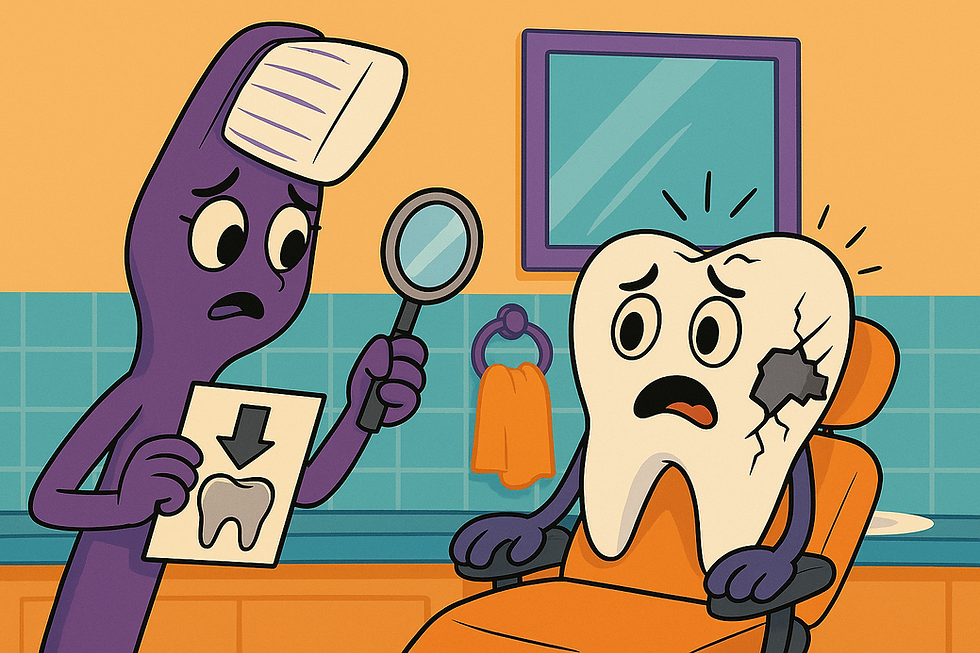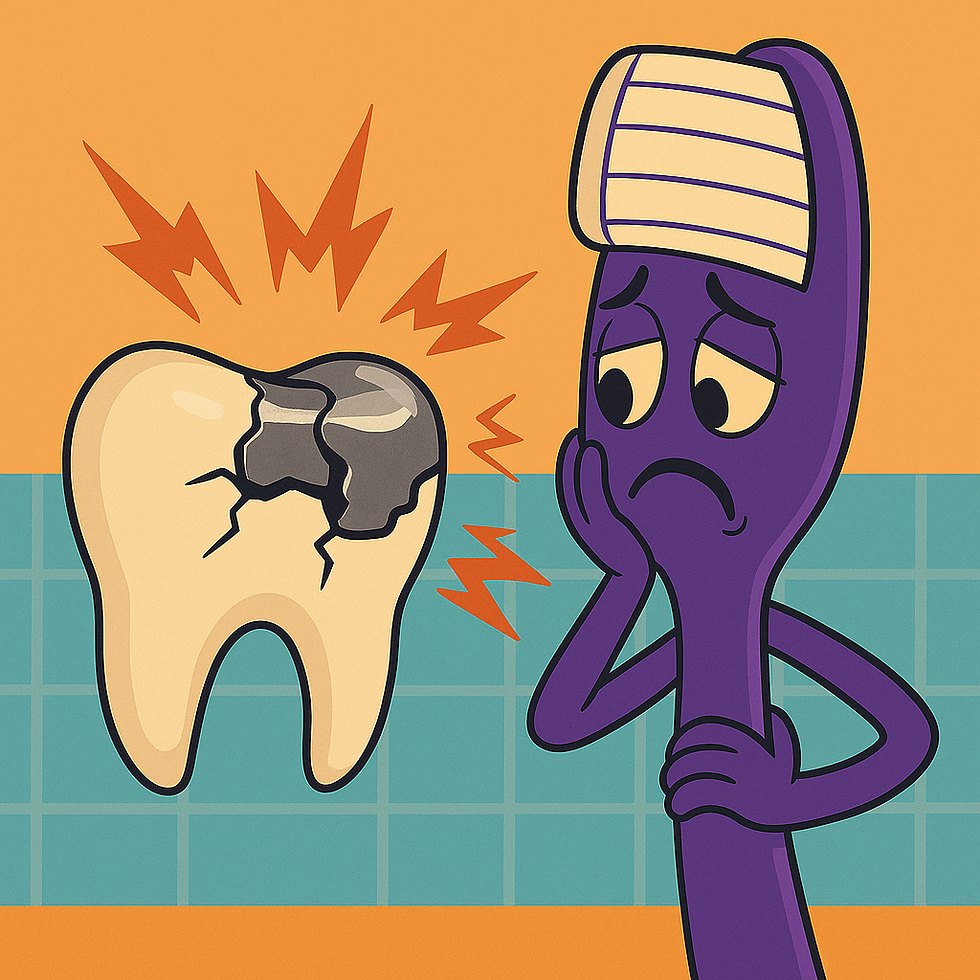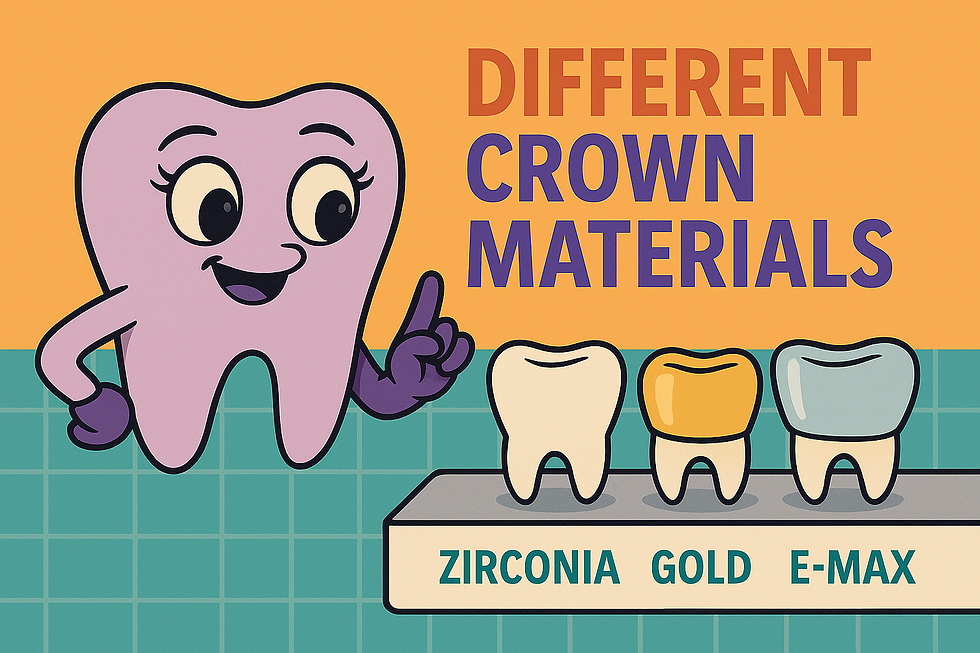Patchwork vs. Protection: Why Your Large Silver Fillings Might Need an Upgrade (Backed by Science)
- naytoghlo
- Apr 23
- 5 min read
Updated: May 6

Hello everyone, this is Dr. Noor!
We often see patients who have been diligent with their dental care for years. Their mouths sometimes tell a story – a history of battles fought against cavities, often marked by several silver-colored fillings, some of them quite large. These amalgam fillings have been workhorses in dentistry for over a century! But as materials science and our understanding of tooth biomechanics have advanced, the conversation around very large amalgam fillings has shifted, and this isn't just opinion – it's based on real, contemporary data.

Let's be clear: amalgam (that silver-mercury alloy) served its purpose well, especially for smaller cavities. It's durable and cost-effective. However, when we talk about fillings that replace a significant portion of a tooth, especially the cusps (those pointy biting surfaces), the long-term picture changes, and the evidence becomes quite compelling.
The Problem with Large Amalgam Fillings: What the Evidence Shows
Think of a tooth with a massive amalgam filling. Here’s what decades of clinical observation and foundational scientific studies tell us, principles that remain valid today:
The Wedge Effect & Lack of Bonding: Amalgam doesn't chemically bond or integrate with your tooth structure. It essentially sits in the prepared space. Over time, chewing forces can cause this large, unbonded filling to act like a wedge, putting internal stress on the remaining, often thinner, natural tooth walls. This lack of integration is a key biomechanical disadvantage compared to modern bonded materials.
Fracture Risk – The Big Concern: Foundational research clearly established that teeth become significantly weaker as more structure is removed for fillings, and large amalgam restorations, lacking bonding, don't restore that lost strength [1]. Clinical experience and older studies consistently showed a higher incidence of tooth fracture (especially cusp fractures) in teeth restored with very large amalgam fillings [2]. While large head-to-head trials comparing modern indirects specifically against large amalgams are less common now (as focus shifts to comparing bonded options), the underlying principle remains: large, non-bonded fillings leave teeth vulnerable. The larger the amalgam, the higher the risk of the remaining walls eventually fracturing under pressure.
Expansion and Contraction: Amalgam expands and contracts with temperature changes differently than tooth structure. Over years, this can create micro-stresses, potentially leading to marginal breakdown or contributing to stress fractures within the tooth.


OUCH!!!
Enter Modern Indirect Restorations: Crowns, Onlays, and Inlays
This is where materials like porcelain (like Emax), zirconia, and sometimes gold come into play, crafted outside your mouth (indirectly) in a lab or with chairside milling technology.

They Bond! Modern materials are often bonded directly to your tooth structure using dental adhesives. This doesn't just fill the hole; it helps to reinforce the remaining tooth, essentially holding it together. Biomechanical studies have demonstrated this reinforcing effect, showing bonded restorations can restore tooth stiffness closer to that of an intact tooth, unlike amalgam [3].
Strength and Cuspal Coverage – A Proven Benefit: Materials like monolithic zirconia are extremely strong and fracture-resistant, making them excellent choices for posterior teeth. Recent systematic reviews confirm the high survival rates and clinical success of zirconia crowns in the demanding posterior region [4]. More importantly, restorations like onlays and crowns cover the vulnerable cusps (cuspal coverage). This is critical. A 2021 clinical study directly evaluating extensive posterior restorations found that those with cuspal coverage had significantly better longevity and fewer failures (like fractures) compared to large restorations without cuspal coverage [5]. This strongly supports the principle that protecting the cusps is key for heavily restored teeth.
Precision Fit: Lab-fabricated or milled restorations allow for a highly precise fit, which helps ensure better marginal seals over the long term, reducing the risk of recurrent decay.
"But My Last Dentist..." – Understanding the Evolution of Care
Now, you might be thinking, "My previous dentist placed these large fillings years ago, were they wrong?" Not necessarily! Dentistry is a constantly evolving field.
Standards Evolve with Data: What was considered the standard of care decades ago is different today, precisely because of the accumulation of long-term outcome data and biomechanical studies like those cited. We have better materials and a deeper understanding now.
Financial Considerations: Sometimes, a large amalgam might have been chosen as a more budget-friendly option at the time, perhaps the best choice available under those specific circumstances.
Patchwork Progression: Often, a tooth gets fillings progressively larger over time. You can reach a point where the filling significantly outweighs the remaining tooth – that's when current evidence strongly suggests a change in approach is needed.
The Science is Clear: We Aren't Making This Up!
The shift towards recommending indirect restorations (like crowns or onlays) for teeth with extensive damage isn't based on whim. It's driven by a robust body of scientific evidence and clinical outcome data highlighting the biomechanical weaknesses of large, non-bonded fillings and demonstrating the superior longevity and protective effect of bonded, cuspal-coverage restorations [4, 5]. The professional consensus today, reflected in current dental literature and education, strongly favors protecting these heavily restored teeth.

So, if you have several large, old amalgam fillings, especially if you've experienced chipping or fractures, or if we identify significant stress lines, it's time for a conversation based on current evidence. While an indirect restoration like a crown or onlay represents a greater upfront investment, the data strongly suggests it's often the better investment in your long-term dental health, significantly reducing the risk of future fractures and potentially more complex treatments. It's about moving from ongoing patchwork to durable, protective, and scientifically supported solutions that align with today's standards of care.
Accepting that those old fillings might now be liabilities according to current understanding is the first step. The next is embracing modern dentistry's evidence-based ways to strengthen those teeth for years to come.
Let's talk about what the science recommends for your specific situation and how we can ensure your smile stays strong and healthy!
Warmly,
Dr. Noor N. Ay Toghlo
References:
Reeh ES, Messer HH, Douglas WH. Reduction in tooth stiffness as a result of endodontic and restorative procedures. J Endod. 1989;15(11):512-516. doi:10.1016/S0099-2399(89)80191-8 (This foundational study quantifies tooth weakening from preparation, underpinning the need for reinforcing restorations).
Plasmans PJ, Creugers NH, Mulder J. Long-term survival of extensive amalgam restorations. J Dent Res. 1998;77(3):453-460. doi:10.1177/00220345980770030501 (A key clinical study observing failure modes, including fracture, in large amalgams over time).
Soares PV, Santos-Filho PC, Queiroz EC, et al. Fracture resistance and stress distribution in endodontically treated teeth restored with fiber-reinforced composite posts and composite cores or metallic posts. J Prosthet Dent. 2008;99(2):120-128. doi:10.1016/S0022-3913(08)60030-4 (Example of biomechanical research showing bonded materials can better distribute stress and reinforce teeth compared to non-bonded approaches).
Mainjot AK, Schlenz MA, Gomez ESA, et al. Monolithic Zirconia Crowns in the Posterior Dentition: A Systematic Review and Meta-Analysis of Clinical Studies. Materials (Basel). 2022;15(15):5195. Published 2022 Jul 25. doi:10.3390/ma15155195 (Recent systematic review confirming the high clinical success and survival rates of strong, modern zirconia crowns used for indirect restorations).
Bresser RA, van de Sande FH, Cenci MS, et al. Longevity of extensive posterior composite resin restorations with and without cusp coverage. J Dent Res. 2021;100(11):1238-1244. doi:10.1177/00220345211008967 (Recent clinical study demonstrating significantly better longevity for extensive restorations when cusps are covered, directly supporting the benefit of onlays/crowns over large fillings)
(Disclaimer: Access to the full text of some articles may require a subscription or institutional access. The references provided support the points made regarding fracture risk associated with large non-bonded fillings and the evidence supporting bonded, cuspal-coverage indirect restorations based on current scientific literature.)



Comments